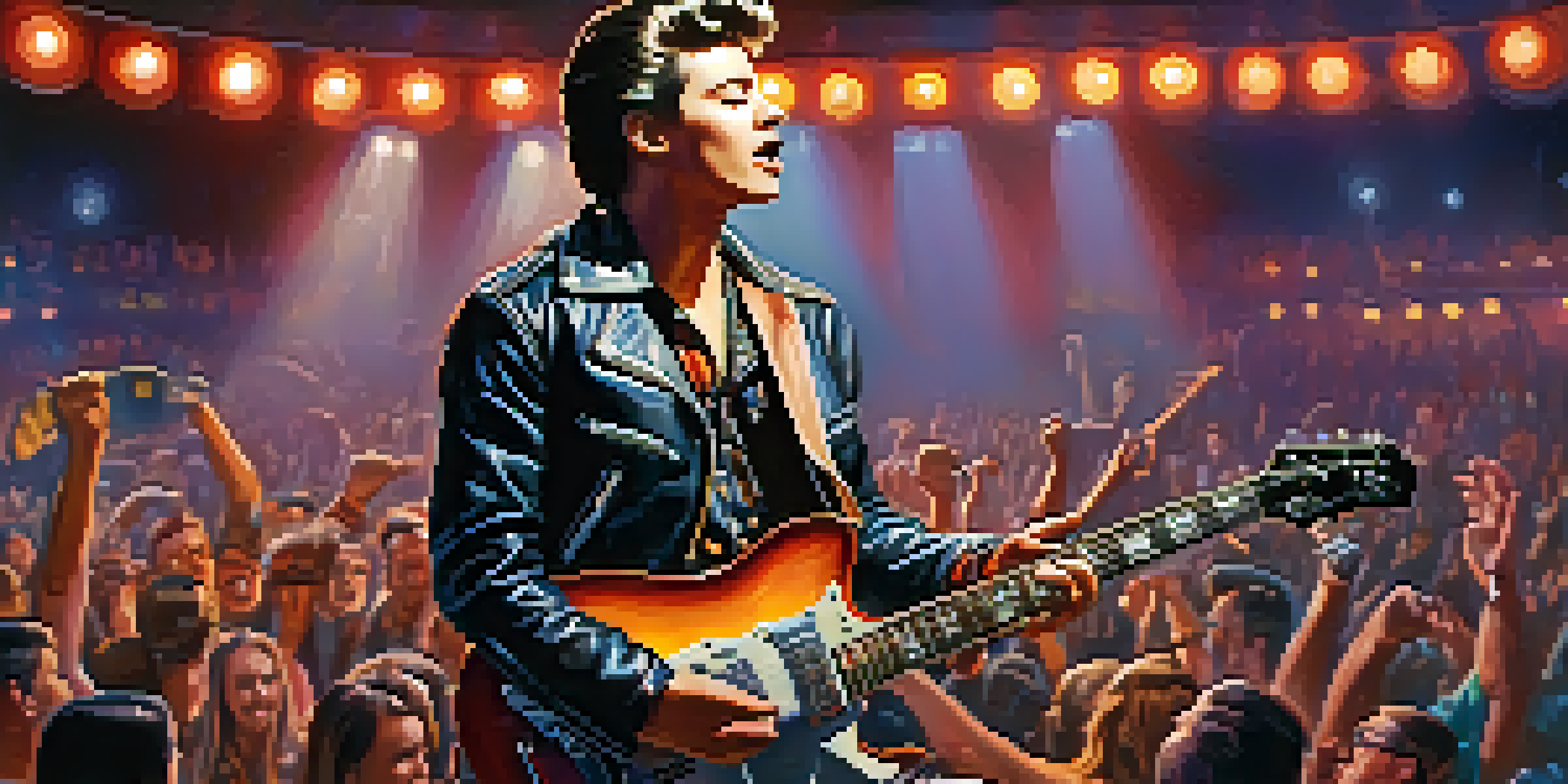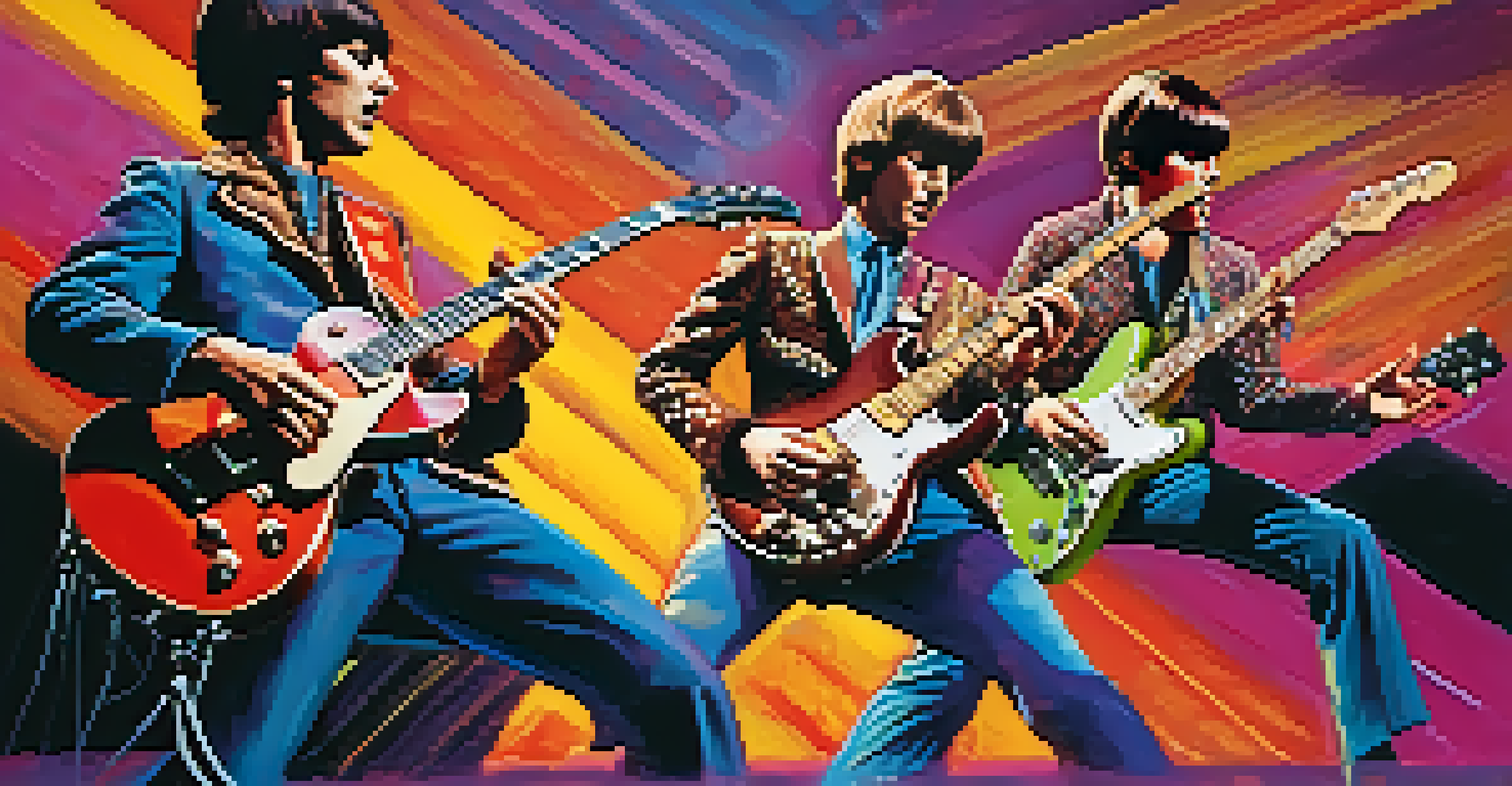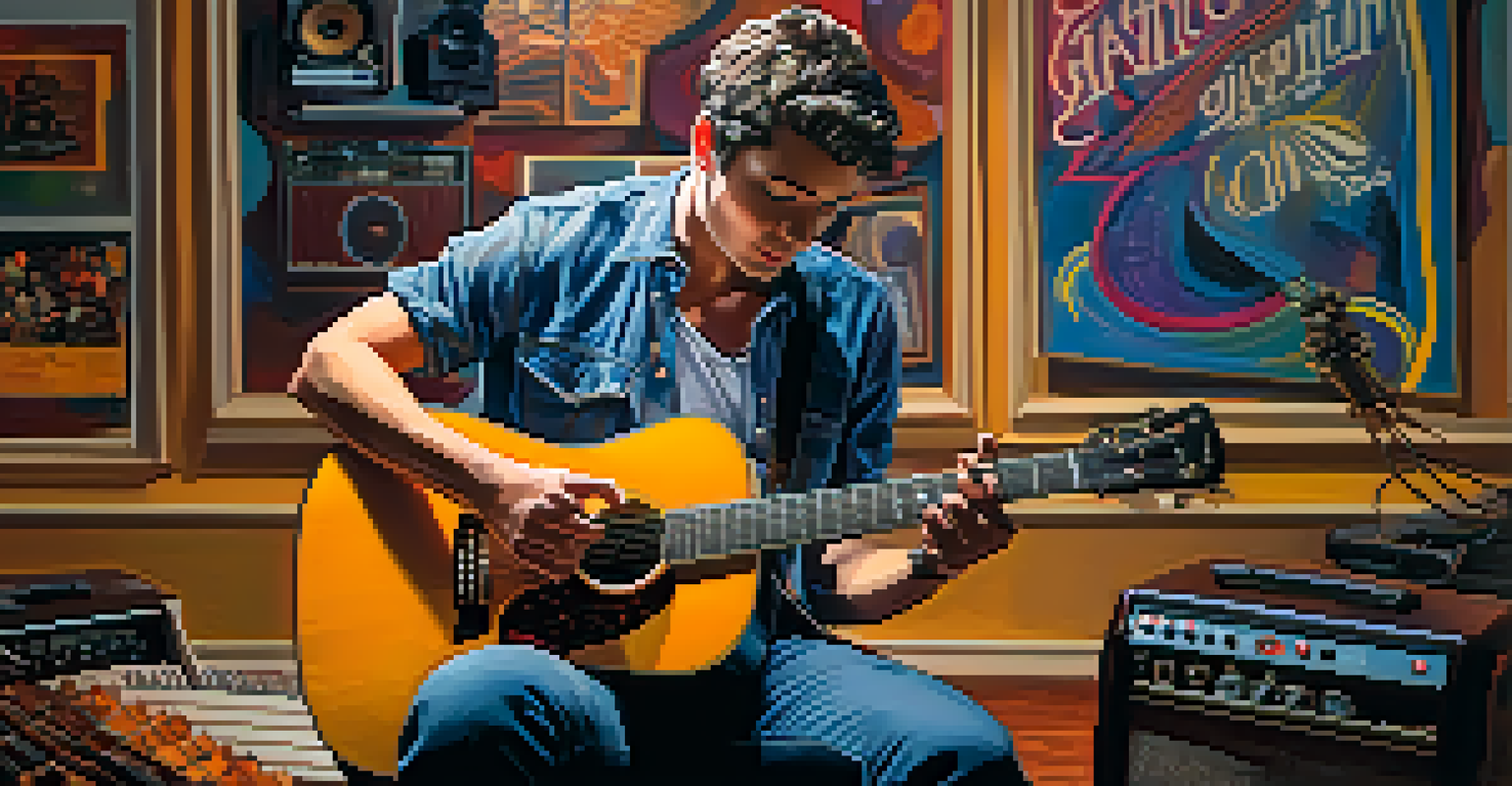Guitar Legends: A Timeline of Icons Through the Decades

The Birth of Rock: 1950s Guitar Pioneers
The 1950s marked a revolutionary era in music, with the guitar emerging as a central instrument in rock and roll. Icons like Chuck Berry and Buddy Holly paved the way, infusing rhythm and melody into the genre. Their innovative techniques and catchy riffs captivated audiences and laid the groundwork for future musicians. It's hard to imagine today's music without the raw energy and creativity they brought to the stage.
The guitar is the most powerful weapon in the world, and the most versatile instrument.
Berry's signature style, characterized by his distinctive duck walk and electrifying solos, not only shaped rock music but also influenced countless guitarists. Holly, with his melodic sensibility and songwriting prowess, introduced a new way of thinking about the guitar in popular music. Together, they sparked a movement that would change the landscape of music forever.
As we look back at this decade, it's clear that these pioneers didn't just play the guitar; they redefined its role in music. Their legacies continue to inspire new generations of musicians, reminding us of the power and potential of the instrument.
The British Invasion: 1960s Guitar Icons
The 1960s ushered in the British Invasion, bringing a wave of guitar legends who would dominate the airwaves. Bands like The Beatles and The Rolling Stones showcased the guitar in exciting and innovative ways. With their unique styles and compelling performances, they captured the hearts of music lovers globally and inspired a whole new generation of guitarists.

The Beatles’ use of harmonized guitar melodies and intricate arrangements changed the way music was composed and performed. Meanwhile, The Rolling Stones introduced a raw, bluesy edge that showcased the guitar's versatility. Other influential artists, such as Eric Clapton and Jimi Hendrix, pushed the boundaries further, experimenting with distortion and feedback to create unforgettable sounds.
Guitar's Evolution Through Decades
The guitar has continually evolved, with each decade introducing innovative techniques and styles that have shaped its role in music.
This decade solidified the guitar's position as a staple in rock music, proving that it could convey a wide range of emotions and styles. The legacies of these guitarists continue to echo in today's music, reminding us of the transformative power of their creativity.
The Guitar Gods: 1970s Rock Legends
The 1970s introduced a new breed of guitar legends who took rock music to unprecedented heights. Icons like Jimmy Page, Jimi Hendrix, and Jeff Beck became known for their virtuosic skills and innovative playing techniques. This decade saw the rise of hard rock and heavy metal, with the guitar at the forefront of this musical evolution.
The guitar is a piece of art, and it should be treated as such.
Jimmy Page's iconic riffs with Led Zeppelin, combined with Hendrix’s groundbreaking use of effects pedals, showcased how the guitar could be used as a powerful storytelling device. Jeff Beck's genre-defying style blended rock, jazz, and blues, pushing the limits of what the instrument could achieve. Their contributions significantly shaped the sound of rock music and set new standards for guitar playing.
In a world captivated by their sound, these legends created anthems that are still celebrated today. They not only left behind an impressive catalog of music but also inspired countless guitarists to explore and innovate, ensuring the guitar's place at the heart of rock music.
The Rise of Alternative: 1980s Guitar Innovators
The 1980s saw the rise of alternative and punk rock, bringing forth a new generation of guitarists who embraced a different sound. Artists like Kurt Cobain of Nirvana and The Edge from U2 redefined guitar playing with their unique styles and approaches. This decade emphasized creativity and raw emotion over technical perfection, allowing for a diverse range of sounds in music.
Kurt Cobain's grunge guitar riffs characterized the Seattle sound, introducing a more abrasive and honest form of rock. The Edge's use of delay and effects created atmospheric soundscapes that became integral to U2's identity. Their willingness to break the mold inspired many young musicians to explore their own sound, leading to a more authentic expression of artistry.
Legacy of Influential Guitarists
Icons from Chuck Berry to contemporary artists like H.E.R. have redefined guitar playing, inspiring generations of musicians and expanding the instrument's reach.
As the 1980s progressed, guitarists continued to innovate, blending genres and experimenting with new techniques. This shift laid the groundwork for the diverse musical landscape we enjoy today, proving that the guitar can adapt and evolve across various genres.
Guitar Evolution: 1990s Grunge and Beyond
In the 1990s, the guitar continued to evolve, influenced by the grunge movement and the rise of alternative rock. Bands like Pearl Jam and Soundgarden showcased a more introspective approach to songwriting, with the guitar playing a crucial role in conveying emotion. This decade also saw the emergence of new genres, including pop-punk and nu-metal, further diversifying the guitar landscape.
Guitarists like Mike McCready and Kim Thayil brought a raw, powerful energy to their music, demonstrating that the guitar could express deep feelings and social commentary. Meanwhile, pop-punk icons like Billie Joe Armstrong of Green Day showcased catchy riffs and anthemic choruses that resonated with a generation. The guitar's adaptability allowed it to thrive in various styles, making it a versatile instrument for new musical expressions.
As the decade came to a close, the guitar remained a central element in popular music. The blend of styles and the unique sounds produced by these guitarists paved the way for future innovations, ensuring the instrument's legacy would continue to flourish.
Modern Mastery: 2000s Guitarists Redefining Sound
The 2000s brought forth a new wave of guitarists who continued to redefine the instrument's role in music. Artists like John Mayer and Jack White emerged, blending various genres and pushing creative boundaries. This decade saw a return to authenticity, with musicians focusing on their personal sound and storytelling through their guitar work.
John Mayer's blues-infused pop and rock resonated with a wide audience, showcasing his exceptional skills and heartfelt songwriting. Meanwhile, Jack White's raw, gritty sound with The White Stripes revived garage rock, proving that simplicity can be powerful. Their unique approaches inspired a new generation of guitarists to explore their own artistic voices.
Guitar's Relevance in Modern Music
Today, the guitar remains a vital instrument in various genres, demonstrating its adaptability and the creative potential of new artists.
As technology advanced, so did the possibilities for guitarists. With the rise of digital tools and social media, musicians could experiment and share their work with a global audience, further expanding the reach of guitar-driven music. The 2000s solidified the guitar's adaptability, ensuring its relevance in an ever-evolving musical landscape.
The New Wave: 2010s Guitarists Shaping the Future
The 2010s witnessed a resurgence of guitar-driven music across various genres, highlighting a new generation of talented musicians. Artists like St. Vincent and Tash Sultana brought fresh perspectives and innovative techniques to the forefront, demonstrating the guitar's continued relevance. This decade emphasized creativity and individuality, with musicians exploring unique sounds and styles.
St. Vincent's intricate arrangements and innovative use of effects challenged traditional guitar playing, while Tash Sultana’s loop-based performances showcased the guitar's versatility in live settings. Their ability to blend genres and experiment with sound pushed the boundaries of what could be achieved with the instrument. The rise of online platforms allowed these artists to reach wider audiences, fostering a community of guitar enthusiasts.

As we look to the future, it's evident that the guitar remains an essential element of music. The creativity and passion of these modern guitarists inspire new players to pick up the instrument, ensuring that the legacy of guitar legends will continue to thrive for generations to come.
The Ongoing Legacy: Guitar Heroes of Today
Today, the guitar remains one of the most influential instruments in music, with a diverse array of artists shaping its future. Contemporary musicians like H.E.R. and Nandi Bushell are redefining what it means to be a guitar hero, bridging genres and connecting with audiences through their talent. Their unique styles and approaches reflect the ongoing evolution of the instrument in a modern context.
H.E.R.'s soulful guitar work and emotive performances have garnered critical acclaim, while Nandi's youthful energy and impressive skills have captured the hearts of fans around the world. Their contributions highlight the importance of diversity and representation in the music industry, inspiring aspiring guitarists from all walks of life. The guitar's role in contemporary music continues to expand, proving that it can adapt to new trends and influences.
As we celebrate the legends of the past, it's essential to recognize the new heroes emerging today. The future of guitar music looks bright, with talented musicians pushing boundaries and exploring new sounds, ensuring that the legacy of guitar legends will never fade.